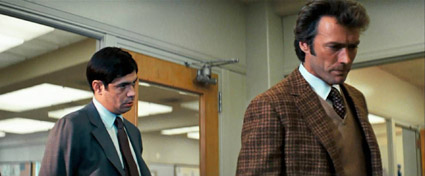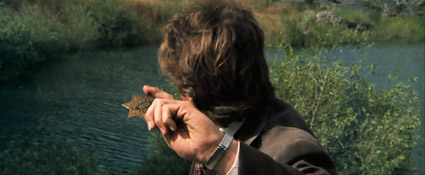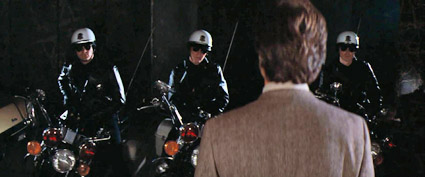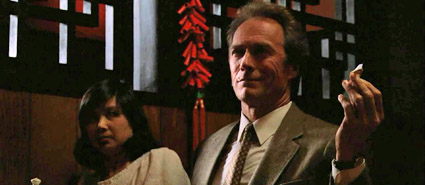
Don Siegel's "Dirty Harry" (1971) may not be the greatest film of Clint Eastwood's career but its title character is certainly the one that best defines it. Looking back, it's hard to imagine it took five years for such an acclaimed picture to arrive here in Mexico. Censorship wasn't common in those days but there was something about "Harry." The only other feature that I can recall getting a similar treatment was "Two Minute Warning" with Charlton Heston. Both dealt with mad snipers on the loose so my guess is that someone decided it was better not to give anyone ideas.
Art and page design by Marie Haws
Inspector Harry Callahan is one of the few screen-icons whose best known quotes can be recited by just about everyone. Frank Sinatra was originally slated for the role but it's impossible to imagine anybody but Clint Eastwood making the character unique. He had little dialogue and never wasted it with small talk. His Mount Rushmore face gives the slightest of smirks only when a criminal meets a particularly gruesome demise and his disgust is usually made evident by the angry display of his lower teeth. Harry never shot anyone who "didn't have it coming" and when he fired his Magnum 44 at a creep holding an innocent hostage, he never missed the creep or hurt the hostage. When he had a gut-feeling it was money in the bank. Viewers were willing to accept whatever methods he applied for getting justice.






Like every long-lasting franchise, the Dirty Harrys included their own set of standard elements which audiences could always anticipate: 1. The introduction of the film and its credits, presented over some aerial shots of beautiful San Francisco. 2. The sight of Harry entering the city's Civic Center (the equivalent of M's office in the Bond series) in order to get chewed up by his incompetent superiors. As Harry would listen to their bureaucratic nonsense, he would always respond sarcastically with a low pitched Yeaaaaaah!, Marvelous!, or Swell!
3. A scene in which Harry gives a cold welcome to his new partner. These characters always belonged to a different race/sex and would soon be witness to their first-ever gruesome crime scene that would invariably make them nauseaous, leading Callahan to utter his "Welcome to Homicide" quip. 4. Just as Harry started warming to a sidekick, the villain would blow them to smithereens, inspiring our hero to go heavy after the evil-doer.
5. Then there's a requisite scene of Harry making his entrance at a business like a supermarket, convenience store or restaurant where some thugs were executing a violent robbery, giving Callahan the perfect excuse to play video-game-like target-practice with the poor bastards. The impact of the bullets would always make them fly through different kinds of glass panes (windows, displays, aquariums, etc.).
6. A scene in which Harry's bosses would remind him of the precise amount (in dollars and cents) that his latest act of destruction had cost the taxpayers and his subsequent demotion to a lesser division in the force such as Personnel or Transit. Being their only member resourceful enough to save the day meant he'd always be reinstated sooner than later.



The story of the first "Dirty Harry" was inspired by the real-life Zodiac killer which shook San Francisco in the early 1970s (even his penmanship is depicted as similar to that in the notorious messages that Zodiac sent to the S.F. Chronicle). The movie is the most ambitious in the series and transformed the enigmatic, unpredictable and faceless Zodiac (with dubious motives) into a more cinematic creep named Scorpio, whose presence was genuinely menacing but intentions standard. "Dirty Harry" was loaded with more sex and violence than any film of the genre up to that point, and it showed no qualms about directing them at characters of every racial group and age. These elements were shocking but felt true to the story nonetheless.
The early "Harry" films incorporated relevant moral and legal dilemmas to their stories. The first entry dealt with Callahan resorting to torture, as depicted by Siegel in a fantastic scene in the middle of a stadium, with a suspect's scream dissipating in the night, as the camera takes-off (literally). These are typical actions for other current, screen characters like Jack Bauer ("24"). What both men share in common are their all-knowing abilities and a precise awareness of the dreadful consequences associated with not acting accordingly. Compare their circumstances to those the Zodiac investigators had to face in real life (no obvious killer, no life or dead deadlines, no clear motives) and you'll understand that Harry Callahan is a magnificent movie figure, but also one who has little to do with reality. What can you say about a cop who is involved in a shoot-out and has no problem with firing his weapon toward a crowd of pedestrians, while chewing on a hot dog?




The plot of "Dirty Harry" had to do with Scorpio trying to extort $100,000 from the city of San Francisco--or else he'll kill an innocent hostage. The authorities comply and Harry is assigned with delivering the ransom, but Scorpio decides to kill him and let the girl die anyway. Callahan manages to catch the creep with his usual non-conventional methods but the DA decides it can't win a trial with non-admissible evidence and drops the case. Scorpio then hires a "professional beater" that leaves him looking as if Harry had taken justice on his own.
By the film's end, Scorpio decides to raise the stakes by kidnapping a schoolbus full of children (as the real Zodiac once threatened to do). Callahan ignores his superiors' orders and takes matters into his own hands, recklessly putting the lives of several children in danger. With this in mind, it would have made sense for the next entry in the series to start similarly to "Rambo II," with Harry being sprung out of a prison to face a new mission. Instead, he's shown back at the job as if nothing ever happened (did he jumped into the pond after his badge?). Whatever its controversies, inconsistencies or departures from reality, "Dirty Harry" provides one a truly original characters and is among the most exciting crime thrillers of all time.






"Magnum Force" (1973) is the second entry in the series and it was written with the clear intent of improving Harry's image following his controversial debut. Callahan is now forced to face a death squad of rookie cops that have been ridding society of its most notorious criminals. He is eventually invited to join the group but their approach is not to his taste. This makes little sense as Harry never had any trouble taking the law into his own hands before (starting with the detonation of this film's very own villain). Maybe Callahan doesn't trust a crew that acts as "judge and jury" unless he gets to play the part of the first.
In general terms, "Magnum Force" is not a very believable movie. Harry is shown taking his partner to his favorite hamburger joint which just happens to be at S.F. International Airport, where coincidentally, he will have to deal with the hijacking of a plane by posing as the "overseas pilot" that the criminals have demanded (does that mean there are also "inland-exclusive" pilots?). Predictably, the craft ends up becoming the site for his latest target practice as Harry rescues a group of innocent passengers (who seem much too happy under the circumstances). The flight attendants don't even bother sitting during take-off. "Force" has an outstanding cast that includes (then) newcomers Tim Matheson, David Soul and Robert Urich.
Unfortunately, it contains several scenes of sex and violence which are seedy, gratuitous and repulsive. Case in point is the massacre at a pool in which the innocent swimmers clearly outnumber the guilty. It was surely included so we'd be able to grasp why Harry would never join such a group but, for a film that tries to make a statement against violence, this one is particularly brutal. The picture does have one of Harry's more notable lines --"A man's got to know his limitations" --but, as cool as it sounds, it doesn't really have much to do with the plot. "Magnum Force" is an ambitious sequel but its ethical predicament is black & white and Callahan's actions contradictory. This is a lesser movie than "Dirty Harry."





"The Enforcer" (1976) is the third entry and surely the best of the sequels. It deals with no real moral dilemma and its scope is much more modest than that of the previous two. This is simply an effective action movie with some great location work and Dirty Harry Callahan at his best. The film has a memorable autopsy scene in which you may end up wondering why any pathologist would need to extract the brain of a victim who clearly died from a stabbing to the back. This is obviously just an excuse for Harry to deliver another of his "Welcome to Homicide" remarks.
"The Enforcer" provides Callahan with his first non-disposable partner (played by Tyne Daly) and the film has a lot of fun showing the very un-PC Harry working with a woman who turns out to be the most competent associate he has ever had. The plot has to do with the nefarious actions by a militant group called "The People's Revolutionary Strike Force" who steal some heavy duty weapons, kidnap the major of San Francisco and hold him for ransom in Alcatraz . This makes for a fantastic site to hold the final confrontation and the ten minutes of action that we get here, pack more excitement than the whole of Clint's "Escape from Alcatraz."






"Sudden Impact" (1983) is the fourth "Dirty Harry" and it was the first and only one to be directed by Eastwood himself. Best remembered for its "Go ahead, make my day" classic line, the picture could be described as Sondra Locke's roaring rampage of revenge as she plays an artist who seeks retribution against the gang of creeps who raped her and her sister. "Impact" was clearly one of the main inspirations of "Kill Bill" as made evident by the victim's red-toned flashbacks and the close-ups of her lost, avenging eyes. All that's missing is the notepad with the crossed-off criminal's names and Tarantino's sense of humor, which the film could have badly used.
Locke's Jennifer Spencer is a Dirty Harriet of sorts; she walks like Harry and utters snappy comebacks just like him. They even have a meet-cute scene in which some charming hostilities are traded. Unfortunately her character doesn't make for a very likable or sympathetic figure, as Tyne Daly did last time around. Their relationship brings to mind the Seinfeld episode in which Jerry falls for Janeane Garofalo, only to later realize that the two are identical in most every way. Point being, it seems that Harry has fallen in love with himself. "Sudden Impact's" main villain is one of the unmemorable wackos that once raped Spencer, accompanied by a couple of accomplices whose only real motive seem to be hanging around with the guy while he commits his crimes. These last two exist for the sole purpose of providing Harry with a higher number of live-targets.
Clint made the wrong choice in setting the film on a picturesque coastal town which doesn't really fit the world of Dirty Harry, despite its unexpectedly high crime rate and endless supply of low-lives. As the credits roll, Harry will let the Locke character walk free in spite of the numerous cold blooded murders she committed, leading us to wonder how Callahan can possibly excuse her actions when she carried them out in the exact same fashion that prompted him to wipe-out the death squad from "Magnum Force." I guess Harry couldn't very well send the female version of himself to prison.



Jackie Chan wannabe.jpg" src="https://static.rogerebert.com/redactor_assets/pictures/far-flung-correspondents/do-i-feel-lucky-well-do-ya-punk/DP4_20Jackie_20Chan_20wannabe.jpg" width="425" height="179" class="mt-image-center" style="text-align: center; display: block; margin: 0px; float: none;">


With the "The Dead Pool" (1988) the series is clearly running on fumes. Harry goes after the serial killer that's been murdering celebrities from a list made by a film director (played by a young Liam Neeson). The picture has no moral agenda and is rather short in sex and violence which means it doesn't feel much like a "Dirty Harry" movie. Callahan does get to add the member of another ethnic group to his list of partners, an Asian-American whose Kung-Fu abilities give this entry the feel of a Jackie Chan buddy-cop feature instead. The guy also provides with the perfect excuse to hold the next shoot-out target-scene at a Chinese Restaurant, allowing Harry to deliver his famous "You forgot your fortune cookie!" quip.
The highlight of "The Dead Pool" is supposed to be the chase scene with an explosive remote control car but it feels totally out of place here (somehow I can't picture Scorpio doing something like this). This sequence raises a couple of obvious questions. How can the villain possibly maneuver the gadget with such precision while simultaneously driving his own car up & down San Francisco's steep hills? (The last time I tried my hand at one of these devices, I drove it off a third-story-balcony to its doom.) How can a tiny model car with a tire-radius twenty times smaller than the real thing, run just as fast?
The end result is the franchise's most embarrassing moment, sort of the equivalent of Shia Lebouf racing the Russians by swinging from vine to vine (with monkeys) in the last "Indiana Jones" movie. "The Dead Pool" is ultimately sunk by the lamest of villains whose motives make no sense; who's not sharp enough to even try getting out of the way of the gigantic, hard to maneuver, harpoon that Harry is aiming at him, and who isn't going to be the source of nightmares to any audience. You know a thriller is in trouble when the serial killer's biggest talent is conducting a remote control car.
"Dirty Harry" is one of the best crime films ever and most of its sequels are not without merit. Unfortunately there comes a time in every movie series when the filmmakers start doing what they think the audience wants them to, instead of what makes for a better picture. As strange as it may sound, the one franchise that the "Dirty Harry's" reminds me the most is the original "Planet of the Apes." The parallels are striking: These are both series which give us a first, groundbreaking and classic entry; a second, mediocre follow-up that badly misfires (both directed by Ted Post); a acceptable (if ambitionless) third movie (both co-starring Bradford Dillman); a fourth that starts to forget what the series is all about and a totally irrelevant fifth that looks nothing like the original that spawned it. Needless to say, a remake of "Dirty Harry" should never even be considered, this is one of the few iconic roles in which the star and the character will forever be one and the same.
Gerardo Valero is lives in Mexico City with his wife Monica. Since 2011 he's been writing a daily blog about film clichés and flubs (in Spanish) on Mexico's Cine-Premiere Magazine. His contributions to "Ebert's Little Movie Glossary" were included in the last twelve editions of "Roger Ebert's Movie Yearbook."





